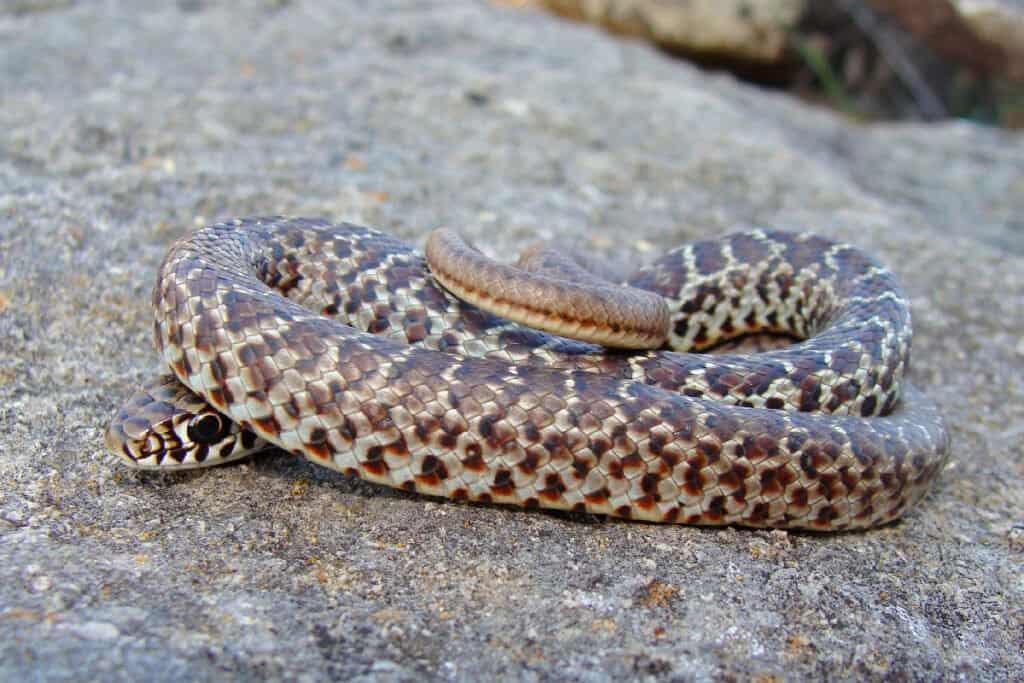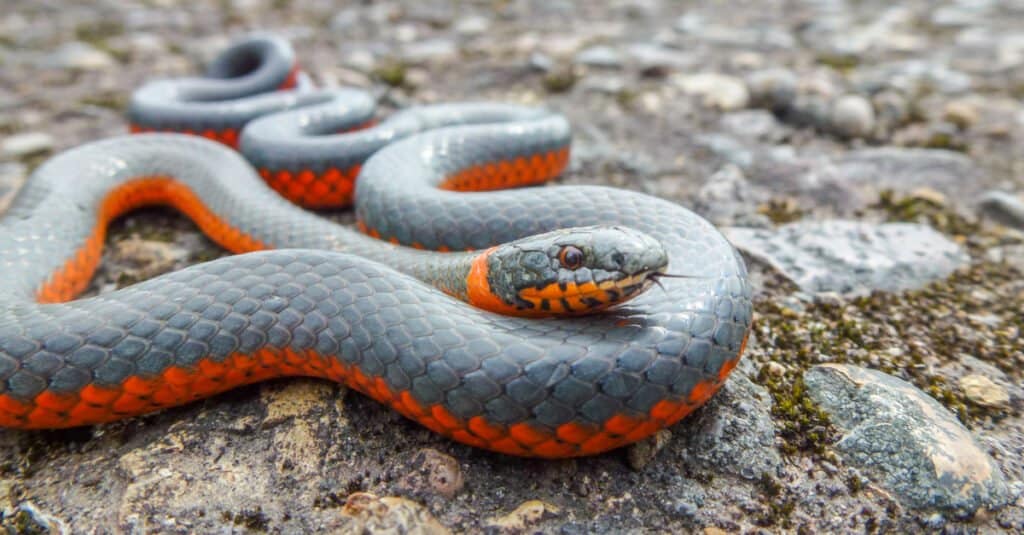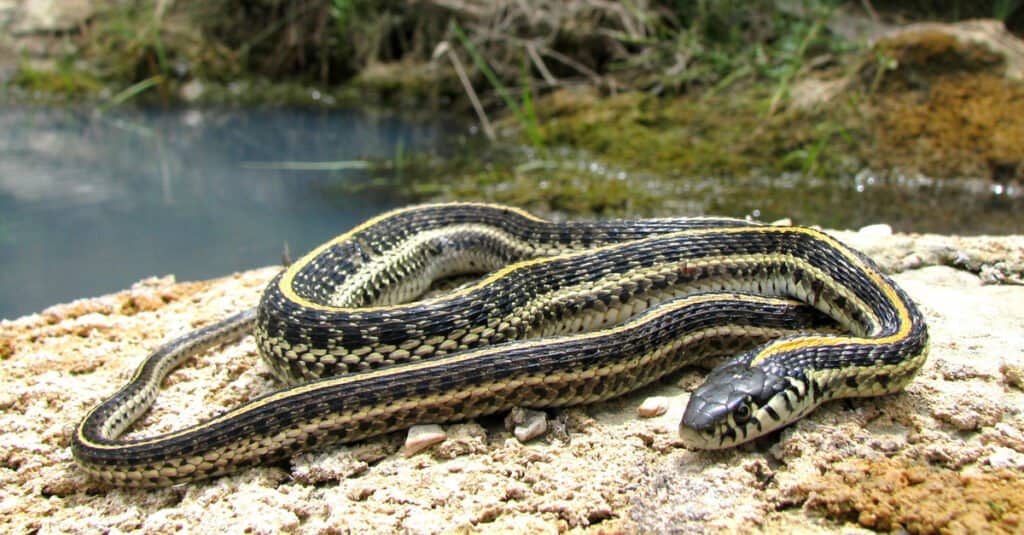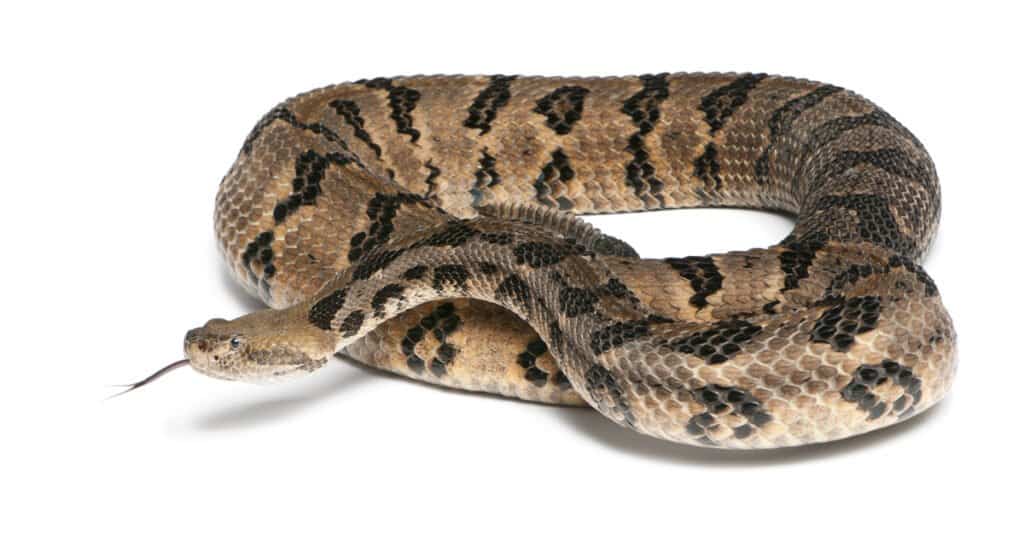17 Snakes Found in Minnesota (2 are Venomous!)
#mobileSnakeQuizControls { overflow: hidden; text-overflow: ellipsis; white-space: nowrap; }
@media (min-width: 481px) {
.mobile-top-content {
display: none;
}
}
#mobileTopContentCTACarouselControls { overflow: hidden; text-overflow: ellipsis; white-space: nowrap; }
.mobile-top-content .more { color: #fff; }
.mobile-top-content a { color: #fff; text-decoration: underline; }
.mobile-top-content a:hover { color: #fff; text-decoration: underline; }
@media (max-width: 480px) {
.mobile-top-content {
background-color: #06a10b;
color: #fff;
text-align: center;
/*height: 60px;
padding-top:5px;*/
font-size:80%;
/* display: block; */
margin: 0px -30px;
}
}
Minnesota is a haven for those who love the outdoors. The Land of 10,000 Lakes has some of the best hiking, camping, and fishing in the country. And because it has so much untouched wilderness it also has a lot of wildlife, including snakes. But even though there are 17 different types of snakes in Minnesota only two of those are venomous. The other 15 are not a danger to humans, although some of them may bite if they are startled or if you come upon them suddenly.
Non-Venomous Snakes In Minnesota
Whether you are a Minnesota native or you’re just visiting to spend time enjoying the many outdoor activities that are available in Minnesota these are some of the different types of snakes you could see in Minnesota:
Eastern Yellowbelly Racer Snake

Matt Jeppson/Shutterstock.com
button.pulse {
transform: scale(1); animation: pulse 2s infinite;
box-shadow: 0 0 0 0 rgba(11, 247, 25, 1);
}
@keyframes pulse {
0% { transform: scale(0.90); box-shadow: 0 0 0 0 rgba(11, 247, 25, 0.5); }
60% { transform: scale(1); box-shadow: 0 0 0 15px rgba(11, 247, 25, 0); }
100% { transform: scale(0.90); box-shadow: 0 0 0 0 rgba(11, 247, 25, 0); }
}
These snakes change color as they get older. So if you see an eastern yellowbelly racer that is tan or cream-colored with brown markings but a thin body and relatively short length it’s a young one. Fully mature Eastern Yellowbelly Racers are a solid gray-green color with a light cream or tan belly. These snakes are not venomous but they can bite if you startle them or try to handle them. They are extremely fast and are more likely to slide away from humans than bite them as long as you keep your distance.
Eastern Fox Snake

Ryan M. Bolton/Shutterstock.com
The eastern fox snake is related to the rat snake. Like its rat snake cousins, it has a heavy wide body and constricts its prey. This snake is non-venomous but it will mimic the actions of venomous snakes in order to scare away predators. The eastern fox snake will often vibrate its tail in leaves or grass to make it sound as if it has a rattle but it’s not a rattlesnake. It also may puff itself up as a threat if it is surprised and feels threatened, but the chances that it will actually strike out are small. The eastern fox snake primarily eats rodents and small birds.
Bullsnake (Gopher Snake)

iStock.com/92968526
The bullsnake is a subspecies of the gopher snake. It has a light body and a color pattern that is similar to the color pattern on a western diamondback rattlesnake, but the bullsnake is not venomous. You can tell a bullsnake from a western diamondback because the bullsnake will be extremely long. These are some of the longest snakes in the country and often measure over eight feet long at full maturity.
Even though bullsnakes aren’t venomous they can be very reactive. They are aggressive towards their prey, but also tend to play dead if a human or larger animal enters their space. However, if you get too close they can get defensive and strike. The best thing to do if you see a bullsnake is to move slowly and deliberately without making any sudden moves and get out of the area. Give the snake plenty of room so that it can flee and it will probably leave instead of striking out.
Ringneck Snake

Tom Fenske/Shutterstock.com
Ringneck snakes are one of the most common types of snakes throughout the country. In Minnesota, they trend to live along the border with Wisconsin. Ringneck snakes can be found from the Canadian border to the border with Iowa, however they narely live more than 50 miles into Minnesota and most sightings are on counties that border Lake Superior or Wisconsin.
These snakes can always be identified by the three distinct rings around their necks by their heads. These rings may be red, tan, or yellow. Ringneck snakes are very interesting to look at but realistically you might never see one. They frequent wooded habitats, brush piles, and the grassy areas around forests but they are nocturnal and tend to dig into the ground or live underground whenever possible. There could be ringneck snakes near you and you would never know it because they are great at hiding.
Plains Garter Snake

Joe Farah/Shutterstock.com
The plains garter snake is perfectly suited to the Minnesota climate because it has a natural resistance to cold that not many snakes have. Snakes usually prefer to be active in warm weather and they hibernate in cold weather, especially a frigid Minnesota winter. But the plains garter snake is active in Minnesota right up until the really cold temperatures set in around November and then it goes dormant until the spring. The sankes can be found across the grasslands on the western side of the state and deciduous forests that run through the middle and southeast of the Minnesota. However, they’re not found in the coniferous forests in the northeastern quadrant of the state.
Plains garter snakes are not that large, typically only a few feet in length. Their bodies are brown or grayish-green and they have either a yellow, red, or orange stripe running down their backs the entire length of their bodies. These snakes also have a set of black bars underneath their lips that makes them easy to identify. Like other types of garter snakes these snakes like grassy areas and the areas near ponds and lakes, which is why you can find them in large numbers throughout Minnesota.
Venomous (Poisonous) Snakes In Minnesota
There are only a couple of venomous snake breeds in Minnesota, and one of them is extremely unlikely to ever come around people. So as long as you are careful and make sure that you don’t surprise a venomous snake or make it feel cornered a venomous snake bite is something you really don’t have to worry about.
Timber Rattlesnake

Eric Isselee/Shutterstock.com
It’s important to note that rattlesnakes are only found in the the southeastern counties in Minnesota that border Wisconsin and Iowa. These include Fillmore, Houston, Winona, and Olmstead county. In the vast majority of the state there have been no timber rattlesnake sightings.
Timber rattlesnakes are impressive looking and also pretty intimidating looking if you see one in the wild. They have wide heavy bodies that aren’t as long as you might think. Typically their main color is yellow, gray, or very dark almost black. They will have distinctive cross markings running down the length of their bodies. Timber snakes are rattlesnakes so they will let you know if you get too close by shaking their tails and unleashing the rattle. They also may puff up or raise their heads to signal they are not afraid. Timber rattlesnakes have a very high concentration of venom and their bites can lead to fatalities in some cases, so even though these snakes are not aggressive you should always be cautious if you do come across one. If bitten by a timber rattlesnake, do not attempt to suck the venom out or adminster heat or ice. Instead you’ll want to get to a hospital that carries antivenom as soon as possible.
Massasauga Rattlesnake

Rusty Dodson/Shutterstock.com
The massasauga rattlesnake is the only other venomous snake in Minnesota and it also lives in the southeastern part of the state. It should be noted that there are no known breeding populations in the state and sightings have been extremely rare.
The massasauga is a very small rattlesnake and often isn’t more than two feet in length. This snake likes a wet habitat and stays near marshland or near the shores of lakes and ponds. You can also sometimes see them in wet grasslands or prairie areas. Massasauga snakes really don’t like people and prefer to stay in the shadows and the tall grass. They will flee from people rather than strike, unless you mistakenly step on one or surprise one. Then it might strike out of fear. If you’re hiking or camping in wet areas or near the edges of the forest keep an eye out for these snakes and keep an ear open too. If you hear a rattle back away slowly and carefully.
What To Do If You Surprise A Snake
It’s not always easy to avoid snakes. They blend in with their surroundings, hide in tall grass, and sometimes there’s just no way to avoid stepping on one or crossing paths with one. The most important thing to do when this happens is not to react. Don’t shout, don’t scream, don’t run, and don’t move fast. Instead, you should freeze. Then assess the situation. If the snake is also stopped then move very slowly back while retracing your steps until you are out of striking distance. Most of the time the snake will flee rather than try to bite you.
A Complete List Of All 17 Snakes In Minnesota
These are all of the snake types that you might find when you’re in Minnesota:
- Eastern yellowbelly racer
- Ringneck snake
- Black rat snake
- Eastern fox snake
- Western hognose snake
- Eastern hognose snake
- Eastern milk snake
- Smooth green snake
- Northern water snake
- Bull snake
- Brown snake
- Northern redbelly snake
- Plains garter snake
- Eastern garter snake
- Lined snake
- Timber rattlesnake
- Massasauga rattlesnake
Discover the “Monster” Snake 5X Bigger than an Anaconda
Every day A-Z Animals sends out some of the most incredible facts in the world from our free newsletter. Want to discover the 10 most beautiful snakes in the world, a “snake island” where you’re never more than 3 feet from danger, or a “monster” snake 5X larger than an anaconda? Then sign up right now and you’ll start receiving our daily newsletter absolutely free.
More from A-Z Animals
.more-snake-card-image { max-height:140px !important; }
#mobileSnakeQuizControls { overflow: hidden; text-overflow: ellipsis; white-space: nowrap; }
@media (min-width: 481px) {
.mobile-top-content {
display: none;
}
}
#mobileTopContentCTACarouselControls { overflow: hidden; text-overflow: ellipsis; white-space: nowrap; }
.mobile-top-content .more { color: #fff; }
.mobile-top-content a { color: #fff; text-decoration: underline; }
.mobile-top-content a:hover { color: #fff; text-decoration: underline; }
@media (max-width: 480px) {
.mobile-top-content {
background-color: #06a10b;
color: #fff;
text-align: center;
/*height: 60px;
padding-top:5px;*/
font-size:80%;
/* display: block; */
margin: 0px -30px;
}
}
Minnesota is a haven for those who love the outdoors. The Land of 10,000 Lakes has some of the best hiking, camping, and fishing in the country. And because it has so much untouched wilderness it also has a lot of wildlife, including snakes. But even though there are 17 different types of snakes in Minnesota only two of those are venomous. The other 15 are not a danger to humans, although some of them may bite if they are startled or if you come upon them suddenly.
Non-Venomous Snakes In Minnesota
Whether you are a Minnesota native or you’re just visiting to spend time enjoying the many outdoor activities that are available in Minnesota these are some of the different types of snakes you could see in Minnesota:
Eastern Yellowbelly Racer Snake

Matt Jeppson/Shutterstock.com
button.pulse {
transform: scale(1); animation: pulse 2s infinite;
box-shadow: 0 0 0 0 rgba(11, 247, 25, 1);
}
@keyframes pulse {
0% { transform: scale(0.90); box-shadow: 0 0 0 0 rgba(11, 247, 25, 0.5); }
60% { transform: scale(1); box-shadow: 0 0 0 15px rgba(11, 247, 25, 0); }
100% { transform: scale(0.90); box-shadow: 0 0 0 0 rgba(11, 247, 25, 0); }
}
These snakes change color as they get older. So if you see an eastern yellowbelly racer that is tan or cream-colored with brown markings but a thin body and relatively short length it’s a young one. Fully mature Eastern Yellowbelly Racers are a solid gray-green color with a light cream or tan belly. These snakes are not venomous but they can bite if you startle them or try to handle them. They are extremely fast and are more likely to slide away from humans than bite them as long as you keep your distance.
Eastern Fox Snake

Ryan M. Bolton/Shutterstock.com
The eastern fox snake is related to the rat snake. Like its rat snake cousins, it has a heavy wide body and constricts its prey. This snake is non-venomous but it will mimic the actions of venomous snakes in order to scare away predators. The eastern fox snake will often vibrate its tail in leaves or grass to make it sound as if it has a rattle but it’s not a rattlesnake. It also may puff itself up as a threat if it is surprised and feels threatened, but the chances that it will actually strike out are small. The eastern fox snake primarily eats rodents and small birds.
Bullsnake (Gopher Snake)

iStock.com/92968526
The bullsnake is a subspecies of the gopher snake. It has a light body and a color pattern that is similar to the color pattern on a western diamondback rattlesnake, but the bullsnake is not venomous. You can tell a bullsnake from a western diamondback because the bullsnake will be extremely long. These are some of the longest snakes in the country and often measure over eight feet long at full maturity.
Even though bullsnakes aren’t venomous they can be very reactive. They are aggressive towards their prey, but also tend to play dead if a human or larger animal enters their space. However, if you get too close they can get defensive and strike. The best thing to do if you see a bullsnake is to move slowly and deliberately without making any sudden moves and get out of the area. Give the snake plenty of room so that it can flee and it will probably leave instead of striking out.
Ringneck Snake

Tom Fenske/Shutterstock.com
Ringneck snakes are one of the most common types of snakes throughout the country. In Minnesota, they trend to live along the border with Wisconsin. Ringneck snakes can be found from the Canadian border to the border with Iowa, however they narely live more than 50 miles into Minnesota and most sightings are on counties that border Lake Superior or Wisconsin.
These snakes can always be identified by the three distinct rings around their necks by their heads. These rings may be red, tan, or yellow. Ringneck snakes are very interesting to look at but realistically you might never see one. They frequent wooded habitats, brush piles, and the grassy areas around forests but they are nocturnal and tend to dig into the ground or live underground whenever possible. There could be ringneck snakes near you and you would never know it because they are great at hiding.
Plains Garter Snake

Joe Farah/Shutterstock.com
The plains garter snake is perfectly suited to the Minnesota climate because it has a natural resistance to cold that not many snakes have. Snakes usually prefer to be active in warm weather and they hibernate in cold weather, especially a frigid Minnesota winter. But the plains garter snake is active in Minnesota right up until the really cold temperatures set in around November and then it goes dormant until the spring. The sankes can be found across the grasslands on the western side of the state and deciduous forests that run through the middle and southeast of the Minnesota. However, they’re not found in the coniferous forests in the northeastern quadrant of the state.
Plains garter snakes are not that large, typically only a few feet in length. Their bodies are brown or grayish-green and they have either a yellow, red, or orange stripe running down their backs the entire length of their bodies. These snakes also have a set of black bars underneath their lips that makes them easy to identify. Like other types of garter snakes these snakes like grassy areas and the areas near ponds and lakes, which is why you can find them in large numbers throughout Minnesota.
Venomous (Poisonous) Snakes In Minnesota
There are only a couple of venomous snake breeds in Minnesota, and one of them is extremely unlikely to ever come around people. So as long as you are careful and make sure that you don’t surprise a venomous snake or make it feel cornered a venomous snake bite is something you really don’t have to worry about.
Timber Rattlesnake

Eric Isselee/Shutterstock.com
It’s important to note that rattlesnakes are only found in the the southeastern counties in Minnesota that border Wisconsin and Iowa. These include Fillmore, Houston, Winona, and Olmstead county. In the vast majority of the state there have been no timber rattlesnake sightings.
Timber rattlesnakes are impressive looking and also pretty intimidating looking if you see one in the wild. They have wide heavy bodies that aren’t as long as you might think. Typically their main color is yellow, gray, or very dark almost black. They will have distinctive cross markings running down the length of their bodies. Timber snakes are rattlesnakes so they will let you know if you get too close by shaking their tails and unleashing the rattle. They also may puff up or raise their heads to signal they are not afraid. Timber rattlesnakes have a very high concentration of venom and their bites can lead to fatalities in some cases, so even though these snakes are not aggressive you should always be cautious if you do come across one. If bitten by a timber rattlesnake, do not attempt to suck the venom out or adminster heat or ice. Instead you’ll want to get to a hospital that carries antivenom as soon as possible.
Massasauga Rattlesnake

Rusty Dodson/Shutterstock.com
The massasauga rattlesnake is the only other venomous snake in Minnesota and it also lives in the southeastern part of the state. It should be noted that there are no known breeding populations in the state and sightings have been extremely rare.
The massasauga is a very small rattlesnake and often isn’t more than two feet in length. This snake likes a wet habitat and stays near marshland or near the shores of lakes and ponds. You can also sometimes see them in wet grasslands or prairie areas. Massasauga snakes really don’t like people and prefer to stay in the shadows and the tall grass. They will flee from people rather than strike, unless you mistakenly step on one or surprise one. Then it might strike out of fear. If you’re hiking or camping in wet areas or near the edges of the forest keep an eye out for these snakes and keep an ear open too. If you hear a rattle back away slowly and carefully.
What To Do If You Surprise A Snake
It’s not always easy to avoid snakes. They blend in with their surroundings, hide in tall grass, and sometimes there’s just no way to avoid stepping on one or crossing paths with one. The most important thing to do when this happens is not to react. Don’t shout, don’t scream, don’t run, and don’t move fast. Instead, you should freeze. Then assess the situation. If the snake is also stopped then move very slowly back while retracing your steps until you are out of striking distance. Most of the time the snake will flee rather than try to bite you.
A Complete List Of All 17 Snakes In Minnesota
These are all of the snake types that you might find when you’re in Minnesota:
- Eastern yellowbelly racer
- Ringneck snake
- Black rat snake
- Eastern fox snake
- Western hognose snake
- Eastern hognose snake
- Eastern milk snake
- Smooth green snake
- Northern water snake
- Bull snake
- Brown snake
- Northern redbelly snake
- Plains garter snake
- Eastern garter snake
- Lined snake
- Timber rattlesnake
- Massasauga rattlesnake
Discover the “Monster” Snake 5X Bigger than an Anaconda
Every day A-Z Animals sends out some of the most incredible facts in the world from our free newsletter. Want to discover the 10 most beautiful snakes in the world, a “snake island” where you’re never more than 3 feet from danger, or a “monster” snake 5X larger than an anaconda? Then sign up right now and you’ll start receiving our daily newsletter absolutely free.







